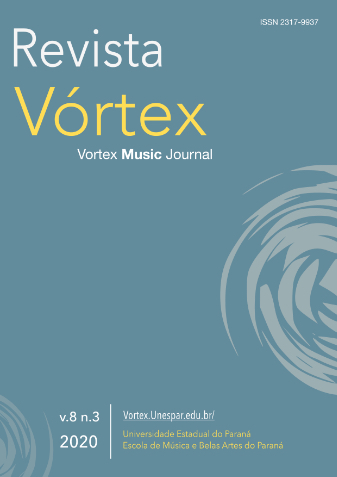Aspects of Villa-Lobos's Tonal Style in Some of His Studies for Guitar
DOI:
https://doi.org/10.33871/23179937.2020.8.3.1.12Keywords:
modernism, tonic madness, tonal pairing, tonal ambiguity, chromatic counterpointAbstract
The goal of this paper is to shed new light on selected strategies that characterize the tonal style of the first nine studies of the set by means of examining Villa-Lobos's treatment of tonality from a perspective that takes into account the role of large-scale structure. I focus on three broad tonal effects that characterize the style of the selected studies, examining in detail some of their specific realizations. I demonstrate how 1) tonal madness may be associated with the deformation of tonic and dominant functions, 2) tonal ambiguity emerges from the presence of opposing tonal forces within the same musical space, and 3) tonal coloring is achieved through chromatic voice-leading, tonally oriented parallelism, and the substitution of standard tonal events. The theoretical foundation combines Schenkerian theory with aspects of Joseph Straus's interdisciplinary studies on musical modernism and disability (2018) and Daniel Harrison's harmonic theory on 19th- and early 20th-century chromatic music (1994).Downloads
References
AMORIM, Humberto. Heitor Villa-Lobos: uma revisão bibliográfica e considerações sobre a produção violonística. Master Thesis. Rio de Janeiro: Universidade do Rio de Janeiro, 2007.
BAILEY, Robert. 1977. "The Structure of the Ring and its Evolution." 19th-Century Music 1: 48–61.
_____.1985. "An Analytical Study of the Sketches and Drafts." In Wagner: Prelude and Transfiguration from "˜Tristan and Isolde"™. Edited by Robert Bailey. New York: Norton, 113–46.
CAPLIN, William. Classical Form: A Theory of Formal Functions for the Instrumental Music of Haydn, Mozart, and Beethoven. New York: Oxford University Press, 1998.
CARLEVARO, Abel. Technique, Analysis and Interpretation of the guitar works of Heitor Villa-Lobos: 12 Studies (vol III). Atlanta: Chanterelle Verlag, 1988.
COHN, Richard. Audacious Euphony: Chromatic Harmony and the Triad"™s Second Nature. New York: Oxford University Press, 2012.
DOLL, Christopher. Hearing Harmony: Toward a Tonal Theory for the Rock Era. Ann Arbor: University of Michigan Press, 2017.
DUDEQUE, Norton. Intertextuality and Stylization in Villa-Lobos"™s Bachianas Brasileiras no. 1. Musica Theorica, Salvador, v. 2, n. 2, p. 19–51, 2017.
_____.The Fugues in the Bachianas Brasileiras by Heitor Villa-Lobos: Neoclassicism and the Learned Style. Revista Música, São Paulo, v. 18, n. 1, p. 67–101, 2018.
FRAGA, Orlando. Os 12 estudos para violão de Villa-Lobos: como os manuscritos podem interferir na interpretação. Anais do I Simpósio Acadêmico de Violão da EMBAP, http://www.embap.pr.gov.br/modules/conteudo/conteudo.php?conteudo=30, 2007.
_____.Phrase Structure and Linear Progression in Villa-Lobos Preludes 1, 2 and 5 for Guitar. https://drive.google.com/file/d/0BzFGBDgE9wsfUHlMalRzUXNEMTQ/view. Undated.
FREITAS, Sergio Paulo Ribeiro de. Ambiguidade: uma palavra-chave na teoria tonal. Revista Vórtex, Curitiba, v. 7, n. 2, p. 1–31, 2019
HARRISON, Daniel. Harmonic Function in Chromatic Music. Chicago: University of Chicago Press, 1994.
_____. Pieces of Tradition. New York: Orxford University Press, 2016.
HATTEN, Robert. Musical Meaning in Beethoven: Markedness, Correlation, and Intepretation. Bloomington: Indiana University Press, 1994.
HEPOKOSKI, James; DARCY, Warren. Elements of Sonata Theory: Norms, Types, and Deformations in the Late Eighteenth-Century Sonata. New York: Oxford University Press, 2006.
KINDERMAN, William; and KREBS, Harald, eds. The Second Practice of Nineteenth-Century Tonality. Lincoln: University of Nebraska Press, 1996.
MEIRINHOS, Eduardo. Fontes Manuscritas e Impressas dos 12 Estudos para Violão de Villa-Lobos. Master Thesis. São Paulo: Universidade de São Paulo, 1997.
MOREIRA, Gabriel Ferrão. A Construção da Sonoridade Modernista de Heitor Villa-Lobos por Meio de Processos Harmônicos: Um Estudo Sobre os Choros. PhD. Diss. São Paulo: Universidade de São Paulo, 2014.
PAZ, Krishna Salinas. Os 12 estudos para violão de Heitor Villa-Lobos: revisão dos manuscritos autógrafos e análise comparativa de três interpretações integrais. Master Thesis. Rio de Janeiro: UFRJ, 1993.
PEREIRA, Marco. Heitor Villa-Lobos: sua obra para violão. Brasília: MusiMed, 1984.
PICCHI, Achille Guido. As serestas de Heitor Villa-Lobos: um estudo de análise, texto-música e pianismo para uma interpretação. PhD. Diss. Campinas: Universidade Estadual de Campinas, 2010.
POMEROY, Boyd. Tales of Two Tonics: Directional Tonality in Debussy"™s Orchestral Music. Music Theory Spectrum, California, v. 26, n. 1, p. 87–118, 2004.
SALLES, Paulo de Tarso. Villa-Lobos: processos composicionais. São Paulo: Editora da Unicamp, 2009.
SCHMALFELDT, Janet. In the Process of Becoming: Analytical and Philosophical Perspectives on Form in Early Nineteenth-Century Music. New York: Oxford University Press, 2011.
SMITH, Peter H. Tonal Pairing and Monotonality in Instrumental Forms of Beethoven, Schubert, Schumann, and Brahms. Music Theory Spectrum, vol. 35 n. 1, p. 77–102, 2013.
STRAUS, Joseph N. Broken Beauty: Musical Modernism and The Representation of Disability. New York: Oxford University Press, 2018.
VISCONTI, Ciro. Simetria nos estudos para violão de Villa-Lobos. Jundiaí: Paco Editorial, 2016.
ZANON, Fabio. Villa-Lobos. São Paulo: Publifolha, 2009.
ZIGANTE, Frédéric. Heitor Villa-Lobos: Douze Études pour guitare seule, édition critique. Paris: Éditions Durant, 2011.
Downloads
Published
How to Cite
Issue
Section
License
Copyright (c) 2021 Gabriel Navia

This work is licensed under a Creative Commons Attribution 4.0 International License.
Autores mantêm os direitos autorais e concedem à revista o direito de primeira publicação, com o trabalho simultaneamente licenciado sob a Licença Creative Commons Attribution que permite o compartilhamento do trabalho com reconhecimento da autoria e publicação inicial nesta revista.






